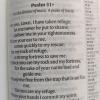Tuning in for Revelation applications in chapters 2-3
This post follows on from two previous posts on the book of Revelation. In the previous posts I argued that the vision of Revelation 4-22 is telling a single, coherent story, and then explained how the first 3 chapters of the book connect to what follows. That structure indicates that it is important to be clear of the messages given in Revelation 2-3 if we are to hear Revelation 4-22 correctly. This post attempts to draw out those messages to the 7 churches, so we can tune in correctly to the visions that follow.










Recent comments